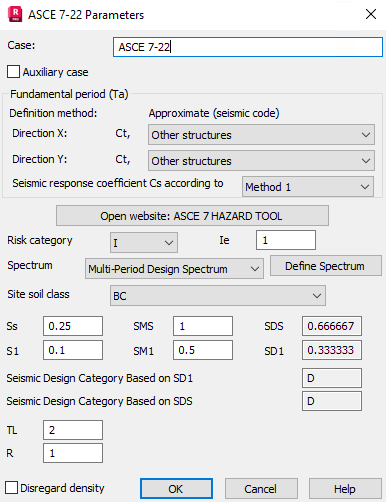Parameters of a structure seismic analysis depend on a seismic code used during calculations of a structure influenced by seismic impact.

To complete the seismic analysis according to the rules given in this code, define the following parameters.
- Risk category
(I, II, III, IV) based on use or occupancy of buildings and structures, classified according to Table 1.5-1.
- Ie - Seismic Importance Factor, based on risk category, as specified in Table 1.5-2.
- Spectrum
There are four spectra available to choose. Two of them - Multi-Period Design Spectrum and Multi-Period MCER Spectrum - require defining the spectrum in the new dialog window, which can be accessed by clicking the 'Define Spectrum' button located next to it.
It is possible to access official ASCE 7 website: ASCE 7 HAZARD TOOL by clicking the 'Open website: ASCE 7 HAZARD TOOL' button. This page allows to obtain values required for defining the spectrum and coefficient values based on basic data such as location, risk category and site soil class.
To transfer the values from the spectrum definition table on the webpage to the definition table in the Robot Structural Analysis, the copy-paste operation can be used.
- Site soil class (A, B, BC, C, CD, D, DE or E) based on the site soil properties, classified according to Chapter 20 of ASCE 7-22.
- Spectral response accelerations
as specified in ASCE 7-22 Section 11.4, and in Chapter 22 of ASCE 7-22:- S1 - Acceleration parameter for 1-second period.
- Ss - Acceleration parameter for short periods.
- SMS is the site adjusted Maximum Considered Earthquake Spectral Response Acceleration Parameter at short periods.
- SM1 - is the site adjusted Maximum Considered Earthquake Spectral Response Acceleration Parameter at a period of 1 s.
You can obtain the values of these parameters at https://asce7hazardtool.online/ site, based on location, risk category and site soil class.
- TL - Long-period transition period, specified according to Chapter 22 of ASCE 7-22.
- R - Response modification coefficient, as specified in ASCE 7-22, Tables 12.2-1, determined by the structure Seismic Force-Resisting System and material.
You can obtain the values of these parameters at https://asce7hazardtool.online/ site, based on location, risk category and site soil class.
Cd - deflection amplification factor, as specified in ASCE 7-22, Table 12.2-1.
Click Eccentricity Definition to open the Definition of mass eccentricities dialog where you can specify how to account for the eccentricity of a mass in the seismic analysis.
Click Base Shear to open the Base shear dialog. There you can select how to take account of the base shear force: calculate it according to the provisions of the seismic code ASCE 7-22 Section 12.8 or specify it.
In case of Base Shear limit is on, the values of internal forces, and reactions are scaled to obtain sum of reactions in the direction of concern equal the Base Shear. Note that the results for each mode are not scaled, but only the results of modal combinations (SRSS, CQC, 10%, 2SM) are scaled.
In case of Base Shear defined manually as User value, the results are always scaled to obtain the sum of reactions in the direction of concern equal the Base Shear, up or down, even if the Base Shear is smaller than the sum of reactions obtained in spectral analysis.
In case of Base Shear calculated Automatically with Fundamental period according to equation 12.8-8, the results are only scaled up to obtain the sum of reactions in the direction of concern equal the Base Shear. They are not scaled down.
In the lower part of the dialog, the Direction definition and Filters buttons are located.
According to the clause 12.9.1.2 reactions and internal forces for each mode of response are divided by the quantity R/Ie. Displacements and drift are multiplied by the quantity Cd/Ie.
You can examine all the input parameters, spectrum details and base shear reduction factor in the Calculation Notes (open Analysis  Calculation Notes
Calculation Notes  Simplified/Full Note)
Simplified/Full Note)
The details concerning this structure analysis method can be found in the mentioned code.
